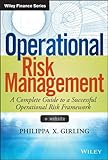Operational risk management : a complete guide to a successful operational risk framework / Philippa Girling.
Material type: TextPublisher number: EB00092648 | Recorded BooksSeries: Wiley finance seriesPublication details: Hoboken : Wiley, ©2013.Description: 1 online resource (xiii, 328 pages) : illustrationsContent type:
TextPublisher number: EB00092648 | Recorded BooksSeries: Wiley finance seriesPublication details: Hoboken : Wiley, ©2013.Description: 1 online resource (xiii, 328 pages) : illustrationsContent type: - text
- computer
- online resource
- 9781118755754
- 1118755758
- 1299939511
- 9781299939516
- 9781118744642
- 1118744640
- 9781118744789
- 1118744780
- 1118532457
- 9781118532454
- 658.155 23
- HD61G575 2013eb
Includes bibliographical references and index.
Print version record.
BA best practices guide to all of the elements of an effective operational risk framework/b While many organizations know how important operational risks are, they still continue to struggle with the best ways to identify and manage them. Organizations of all sizes and in all industries need best practices for identifying and managing key operational risks, if they intend on exceling in today's dynamic environment./ iOperational Risk Management/i fills this need by providing both the new and experienced operational risk professional with all of the tools and best practices needed to implement a successful operational risk framework. It also provides real-life examples of successful methods and tools you can use while facing the cultural challenges that are prevalent in this field./ ulliContains informative post-mortems on some of the most notorious operational risk events of our time/liliExplores the future of operational risk in the current regulatory environment/liliWritten by a recognized global expert on operational risk/li/ul An effective operational risk framework is essential for today's organizations. This book will put you in a better position to develop one iand/i use it to identify, assess, control, and mitigate any potential risks of this nature.
Operational Risk Management; Contents; Preface; Acknowledgments; Chapter 1 Definition and Drivers of Operational Risk; The Definition of Operational Risk; 2012 London Olympics: A Case Study; Test One: Do the Seven Basel Operational Risk Categories Work in the Real World?; Test Two: The Risk Management Tools; Operational Risk Management and Operational Risk Measurement; Operational Risk Management; Operational Risk Measurement; The Relationship between Operational Risk Management and Other Risk Types; Drivers of Operational Risk Management; Key Points; Review Questions; Notes.
Chapter 2 The Regulatory PushHistory of the Basel Accords; Rules of the Accords; Basel I; Basel II; Adoption of Basel II in Europe; Adoption of Basel II in the United States; Securities and Exchange Commission Amendments to the Net Capital Rule; U.S. Regulators' Adoption of New Regulations to Apply Basel II; Impact of the Financial Crisis; The Promise of Basel III; European Response to the Crisis; U.S. Response to the Crisis; The Future; Key Points; Review Questions; Notes; Chapter 3 The Operational Risk Framework; Overview of the Operational Risk Framework; The Foundations of the Framework.
GovernanceCulture and Awareness; Policies and Procedures; The Four Data Building Blocks; Loss Data Collection; Risk and Control Self-Assessment; Scenario Analysis; Key Risk Indicators; Measurement and Modeling; Reporting; Risk Appetite; Key Points; Review Questions; Note; Chapter 4 Operational Risk Governance; Role of Governance; First Line of Defense; Second Line of Defense; Who Should Own the Operational Risk Function?; What Should the Operational Risk Function Own?; Third Line of Defense; Audit; Validation and Verification; Risk Committees; Key Points; Review Questions; Notes.
Chapter 5 Culture and AwarenessWinning Over the Firm; Marketing and Communication; Training; Planning; The "Use Test"; Key Points; Review Question; Note; Chapter 6 Policies and Procedures; The Role of Policies, Procedures, Guidelines, and Standards; Best Practices; Operational Risk Policy; Sample Operational Risk Policy; Sample Standards, Procedures, and Guidelines; Extract from a Loss Data Standards Document; Extract from a Loss Data Procedures Document; Extract from a Loss Data Guidelines Document; Linkage between Documents; Key Points; Review Question; Chapter 7 Internal Loss Data.
Operational Risk Event DataInternal Loss Data or Internal Operational Risk Events; Why Collect Operational Risk Event Data?; Who Should Collect the Loss Data?; What Should Be Collected in the Loss Data Program?; Risk Event Categories; Internal Fraud; External Fraud; Employment Practices and Workplace Safety; Clients, Products, and Business Practices; Damage to Physical Assets; Business Disruption and System Failures; Execution, Delivery, and Process Management; Using the Basel Risk Categories; Minimum Loss Data Standards; Comprehensive; Threshold; Amount; Date; Description and Causes.
Media and Communication
